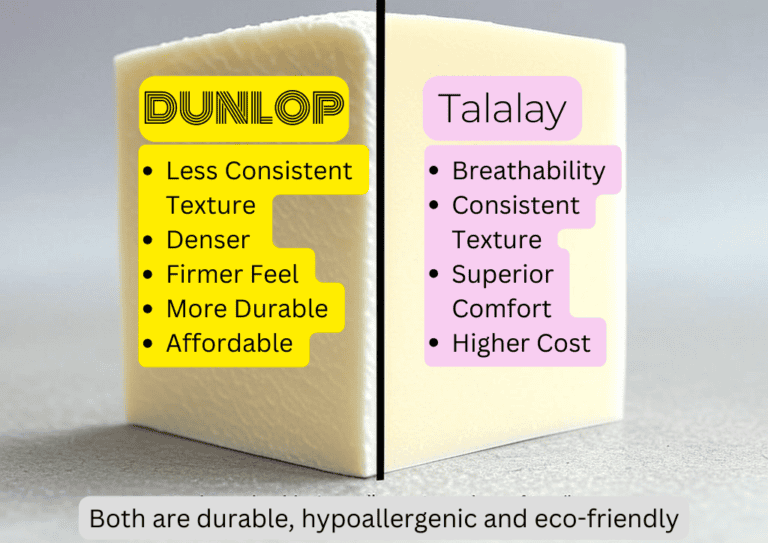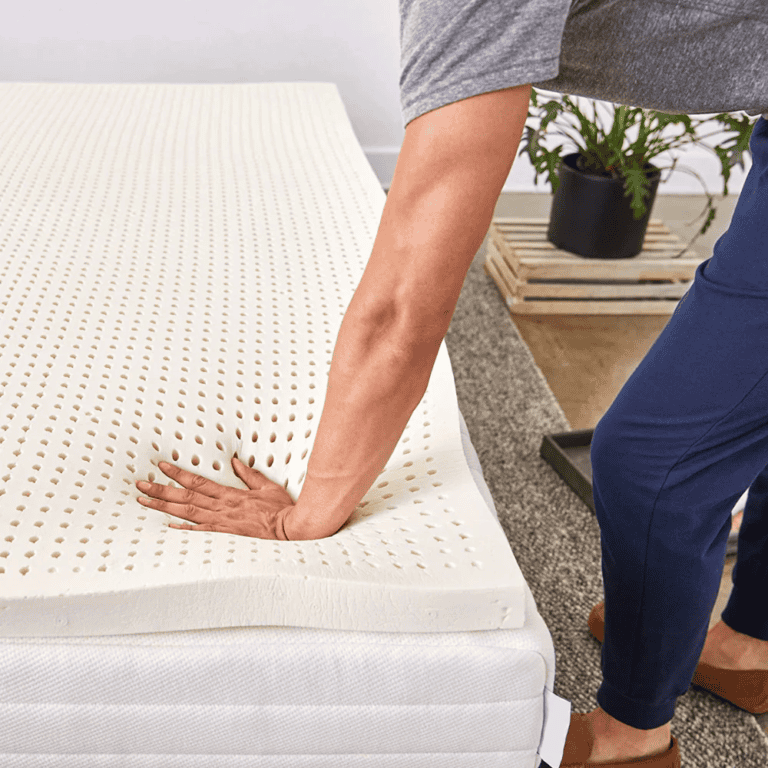Memory Foam vs Hybrid Mattress: Which is Best for You in 2025
Choosing the right mattress can feel overwhelming with so many options on the market. Should you sink into the contouring comfort of a memory foam mattress or enjoy the balanced support of a hybrid mattress? The decision often comes down to personal preferences, sleep habits, and budget. Did you know that poor mattress selection can affect your health and productivity? Let’s dive into the details of Memory Foam vs Hybrid Mattress, these two popular options so you can make an informed choice that suits your sleep style perfectly!
Table of Contents
What Is a Memory Foam Mattress?
Overview of memory foam material and how it works.
Memory foam mattresses are made from a unique type of polyurethane foam that’s designed to contour to your body. What makes memory foam special is its ability to soften when exposed to heat and pressure, molding around your shape and then slowly bouncing back when the weight is removed. This feature not only feels super cozy but also provides personalized support, which can be a game-changer for many sleepers.
Origins of memory foam technology (developed by NASA!).
You might be surprised to learn that memory foam wasn’t originally invented for mattresses. It was actually developed by NASA in the 1970s as a way to improve seat cushioning and crash protection for astronauts. The material, officially called viscoelastic foam, eventually found its way into consumer products like mattresses, pillows, and even shoes. Pretty cool, right? It’s like sleeping on a material that’s literally out of this world.
Key features: contouring, pressure relief, motion isolation.
One of the best things about memory foam is how it hugs your body to relieve pressure on your joints and muscles. This makes it particularly great for people with chronic pain or those who wake up with stiff shoulders or hips. Plus, it’s fantastic at isolating motion, so if your partner tosses and turns all night, you won’t feel a thing. That’s why memory foam is often compared to a “hugging” sensation—it cradles you without disturbing your sleep.
Types of sleepers who benefit most from memory foam mattresses.
So, who is memory foam really for?
Side sleepers tend to love it because it cushions the shoulders and hips while keeping the spine aligned. People with back or joint pain also rave about its pressure-relieving properties.
And if you’re someone who wakes up every time your partner or pet moves, memory foam might be your best friend.
It’s not perfect for everyone—hot sleepers, in particular, might need a model with cooling tech—but for many, it’s a dream come true.
What Is a Hybrid Mattress?
Explanation of hybrid mattresses.
A hybrid mattress is pretty much what it sounds like—a blend of two popular mattress types. It combines a coil-based support system, like you’d find in a traditional innerspring mattress, with a thick foam comfort layer on top. The result? You get the best of both worlds: the support and bounce of coils with the contouring and cushioning of foam. It’s all about striking that perfect balance for a comfy night’s sleep.
Key features: balance of support and comfort, breathability.
One of the standout features of hybrid mattresses is their ability to balance support and comfort. The foam layers on top relieve pressure on your body, while the coils provide a sturdy base to keep your spine aligned. Plus, the coil system allows for plenty of airflow, making hybrids naturally more breathable than all-foam options. This can be the sleep-saver if you tend to overheat at night.
Types of sleepers who benefit most from hybrid mattresses.
Hybrid mattresses work well for a wide range of sleepers, but they’re especially great for combo sleepers—those who switch between sleeping on their back, stomach, or side. The coils offer the responsiveness needed to move around easily, while the foam layers cushion pressure points.
They’re also a great pick for hot sleepers and couples, thanks to the breathability and motion isolation.
Common misconceptions about hybrid mattresses.
One misconception about hybrids is that they’re all super expensive. While it’s true that some luxury models can be pricey, there are budget-friendly options that still offer great features. Another myth? Some people think hybrids are just glorified innersprings, but the foam layers are much more advanced than the thin padding you’d find in an old-school mattress. It’s a whole different sleeping experience—one worth trying if you want that balance of bounce and plushness.
Comfort and Support Comparison
Analysis of how each mattress type feels for different sleep positions.
When it comes to choosing a mattress, comfort and support can vary quite a bit between memory foam and hybrid options, especially based on your sleep position. Memory foam tends to excel for side sleepers because it hugs the shoulders and hips, offering a plush feel that helps relieve pressure. On the other hand, hybrid mattresses cater well to back and stomach sleepers, as the coils provide the necessary support to keep the spine aligned without excessive sinking. So, depending on how you sleep, your preference for either type might shift quite a bit.
Discussion of pressure point relief capabilities.
Pressure point relief is another area where these two mattress types show some differences. Memory foam is fantastic at contouring, which helps distribute body weight evenly and reduces pressure on key areas like the hips and shoulders. This is particularly beneficial for those with joint pain. Hybrids also provide good pressure relief, but it can vary more depending on the specific foam used in the comfort layer and the coil construction. In general, both types offer great options for minimizing discomfort during the night, but memory foam typically has the upper hand here.
Comparison of spinal alignment properties.
Spinal alignment is crucial for a restful night’s sleep, and both mattress types have their strengths. Memory foam does a great job of cradling the body, which can help keep the spine in a neutral position, particularly for side sleepers. Hybrids, with their combination of foam and coils, also promote good spinal alignment, especially for back and stomach sleepers who need firmer support to avoid sagging. Ultimately, choosing the right mattress can depend on your sleeping habits and body type, as each offers unique support properties.
Evaluation of edge support differences.
Edge support is another factor to consider when comparing these mattresses. Hybrids generally have better edge support due to their coil systems, which help maintain structure along the perimeter. This is a big advantage if you sit or sleep near the edge of the bed. Memory foam mattresses can sometimes feel like they sag at the edges, making it a bit trickier to use the full surface.
Durability: Lifespan and wear over time.
Durability is a key point in any mattress discussion, and both memory foam and hybrid mattresses have their pros and cons. Memory foam can last anywhere from 7 to 10 years, depending on the quality of materials used, but it may sag or develop impressions over time. Hybrids, thanks to their coil construction, often last a bit longer—typically around 8 to 12 years—if maintained properly. However, the foam layers in hybrids can wear down more quickly if they’re not high-quality.
Price Range: Average costs and value for money.
Finally, let’s talk about price. Generally, memory foam mattresses can range from about $800 to $2,500, depending on brand and materials. Hybrids typically sit in a similar range, around $1,200 to $2,000, but the value for money can be different. Hybrids often provide a more versatile sleep experience with their combination of support and comfort, which may justify a higher price for some. However, there are budget-friendly options in both categories, so it’s always good to shop around to find what fits your needs best.
Pros and Cons of Memory Foam Mattresses
Advantages: Pressure relief, motion isolation, affordability.
One of the biggest advantages is pressure relief. The way memory foam contours to your body can be a game-changer for those with joint pain or discomfort. By distributing weight evenly and cradling sensitive areas like the shoulders and hips, memory foam helps prevent those dreaded pressure points that can lead to tossing and turning throughout the night. Additionally, memory foam excels at motion isolation, which is a huge perk for couples. If your partner gets up frequently or shifts around during the night, you’ll likely feel less of that movement, allowing for a more restful sleep. Plus, many memory foam mattresses are more affordable than their hybrid counterparts, making them a great choice for budget-conscious shoppers.
Disadvantages: Heat retention, lack of bounce.
One of the main complaints is heat retention.
Because the foam conforms so closely to the body, it can trap heat and make some sleepers feel uncomfortably warm during the night. Many manufacturers have started incorporating cooling technologies, like gel-infused foam or breathable covers, but it’s still something to keep in mind if you tend to sleep hot.
Off-gassing.
Lastly, there’s the issue of off-gassing. When you first unbox a memory foam mattress, you might notice a chemical smell that comes from the volatile organic compounds (VOCs) used in the manufacturing process. This is particularly common in lower-quality mattresses and can be a bit off-putting, although the smell usually dissipates after a few days. While these concerns can deter some buyers, many people find that the benefits of memory foam, particularly in terms of comfort and support, outweigh these potential negatives. Ultimately, weighing these pros and cons can help you decide if a memory foam mattress is the right fit for your sleep needs.
There is another feature that can be put in both sections, depending solely on the preferences. That is the lack of bounce that memory foam offers.
While this can be a benefit for motion isolation, it might not be ideal for people who enjoy a bit of spring in their bed, especially for sex or for those who change positions frequently during the night.
Pros and Cons of Hybrid Mattresses
Advantages: Balanced support, durability, good for couples.
One of the standout advantages is balanced support. With the combination of coils and foam, hybrids provide the perfect mix of responsiveness and comfort. This means that back and stomach sleepers get the firm support they need for proper spinal alignment, while side sleepers enjoy the cushioning effect of the foam.
Another significant benefit is durability. The coil support systems in hybrids typically outlast those of all-foam mattresses, making them a solid investment for the long haul.
Plus, for couples, hybrids can be a great choice because they offer excellent motion isolation without sacrificing that supportive bounce that many people prefer. This means you and your partner can enjoy a good night’s sleep without disturbing each other.
Disadvantages: Heavier, more expensive.
One major consideration is their weight. Because of the coils, hybrids are generally heavier than all-foam options, which can make moving them around or setting them up a bit of a workout. This is especially important to think about if you frequently rearrange your bedroom or move homes.
Additionally, hybrids often carry a higher price tag compared to memory foam mattresses, which might not fit every budget. While you can find more affordable options, many hybrids are on the higher end of the price spectrum due to their construction and materials.
Lastly, potential noise can be a concern with hybrid mattresses. The coil systems can produce some sound when weight is applied, especially if you’re moving around a lot or sitting on the edge of the bed. While this isn’t a deal-breaker for most people, it’s something to consider if you’re particularly sensitive to noise during the night.
All in all, weighing these pros and cons can help you determine if a hybrid mattress is the right choice for your sleep needs and lifestyle.
How to Choose the Right Mattress for Your Sleep Style
Side sleepers: Which mattress works best?
If you’re a side sleeper, you’ll want a mattress that offers plenty of pressure relief and cushioning. Memory foam mattresses are often recommended because they contour closely to the body, cradling your shoulders and hips while keeping your spine aligned. Look for a model with a softer comfort layer that can alleviate pressure points, helping you avoid waking up with aches and pains. A hybrid mattress can also work well if it has a plush top layer, providing both support and comfort for side sleepers.
Back and stomach sleepers: Key factors to consider.
For back and stomach sleepers, the key is finding a mattress that maintains proper spinal alignment. Back sleepers usually benefit from a medium-firm mattress that supports the natural curve of their spine. On the other hand, stomach sleepers typically require a firmer mattress to prevent the hips from sinking too much, which can lead to lower back pain. Hybrid mattresses often offer this level of support with their combination of coils and foam. When choosing a mattress, look for one that keeps your body in a straight line while you sleep, which is crucial for avoiding discomfort.
Combo sleepers: Why versatility matters.
If you’re a combination sleeper who shifts positions throughout the night, versatility is key. You’ll want a mattress that can adapt to different sleeping styles, offering both support and comfort no matter how you’re positioned. A hybrid mattress is often a great choice for combo sleepers because they provide a good balance of responsiveness and pressure relief. Look for a model with a medium feel so that it’s not too soft or too firm, making it easier to switch positions without feeling stuck.
Weight and body type considerations.
Finally, it’s essential to consider your weight and body type when selecting a mattress. Heavier individuals typically require more support and durability, so look for mattresses that feature high-density foam or robust coil systems. On the other hand, lighter sleepers may prefer a softer feel, which can help with pressure relief. Always keep in mind that everyone’s preferences can vary, so testing out a few different mattresses can really help you find the perfect fit for your unique needs.
Memory Foam vs Hybrid Mattress: FAQs
–Do hybrid mattresses last longer than memory foam?
Generally speaking, yes, hybrid mattresses tend to have a longer lifespan. The combination of coils and high-quality foam in hybrids often leads to increased durability. While memory foam mattresses can last around 7 to 10 years, hybrids typically last between 8 to 12 years, assuming proper care and maintenance. The coils provide extra support that can help prevent sagging, which is a common issue with all-foam models as they age. So, if longevity is a priority for you, a hybrid might be the better choice.
–Which mattress is better for back pain?
This really depends on your sleep position. For many people, a medium-firm hybrid mattress is often recommended because it provides a good balance of support and comfort, which can help maintain proper spinal alignment. However, some side sleepers may find that a softer memory foam mattress offers better pressure relief for their shoulders and hips, reducing pain in those areas. Ultimately, the best mattress for back pain will depend on personal preferences and specific sleeping styles, so it’s essential to try a few options to see what works best for you.
–Are hybrid mattresses worth the extra cost?
While hybrids often come with a higher price tag, many find the investment worthwhile. The combination of materials means you’re likely getting a more versatile sleeping experience, which can justify the cost. Plus, their durability means you might not need to replace your mattress as often as with a cheaper all-foam option. If you value support, comfort, and longevity, hybrids can definitely provide good value for your money.
–What’s better for hot sleepers?
In this case, hybrids generally have the upper hand. The coil system in hybrid mattresses promotes airflow, which helps dissipate heat, keeping you cooler throughout the night. While many memory foam mattresses now come with cooling technologies, like gel-infused foam or breathable covers, they still can trap heat more than hybrids. So, if temperature regulation is a big concern for you, leaning toward a hybrid mattress might be the best option to keep you comfortable.







